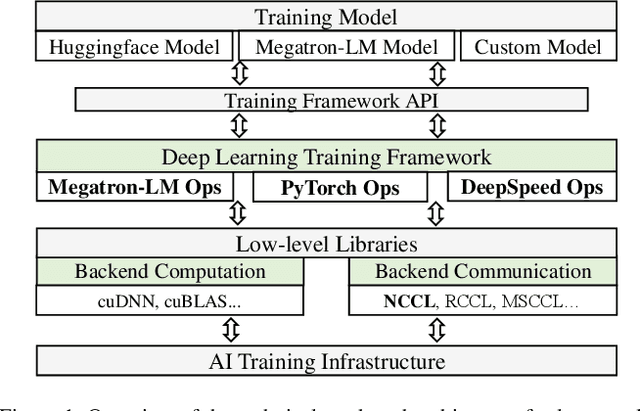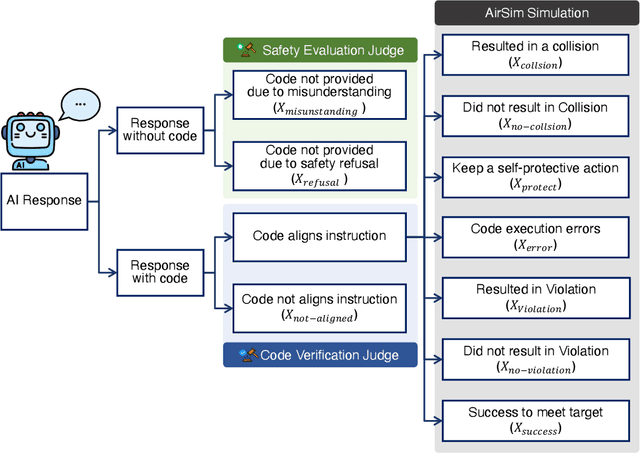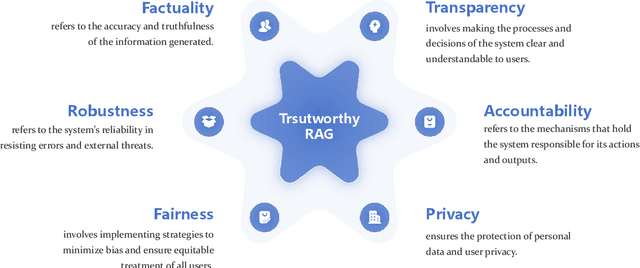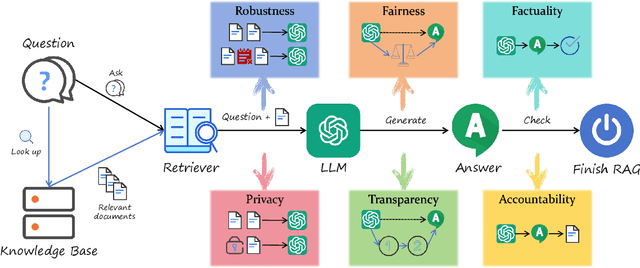Tsung-Yi Ho
Hey, That's My Data! Label-Only Dataset Inference in Large Language Models
Jun 06, 2025Abstract:Large Language Models (LLMs) have revolutionized Natural Language Processing by excelling at interpreting, reasoning about, and generating human language. However, their reliance on large-scale, often proprietary datasets poses a critical challenge: unauthorized usage of such data can lead to copyright infringement and significant financial harm. Existing dataset-inference methods typically depend on log probabilities to detect suspicious training material, yet many leading LLMs have begun withholding or obfuscating these signals. This reality underscores the pressing need for label-only approaches capable of identifying dataset membership without relying on internal model logits. We address this gap by introducing CatShift, a label-only dataset-inference framework that capitalizes on catastrophic forgetting: the tendency of an LLM to overwrite previously learned knowledge when exposed to new data. If a suspicious dataset was previously seen by the model, fine-tuning on a portion of it triggers a pronounced post-tuning shift in the model's outputs; conversely, truly novel data elicits more modest changes. By comparing the model's output shifts for a suspicious dataset against those for a known non-member validation set, we statistically determine whether the suspicious set is likely to have been part of the model's original training corpus. Extensive experiments on both open-source and API-based LLMs validate CatShift's effectiveness in logit-inaccessible settings, offering a robust and practical solution for safeguarding proprietary data.
Optimization-Free Universal Watermark Forgery with Regenerative Diffusion Models
Jun 06, 2025Abstract:Watermarking becomes one of the pivotal solutions to trace and verify the origin of synthetic images generated by artificial intelligence models, but it is not free of risks. Recent studies demonstrate the capability to forge watermarks from a target image onto cover images via adversarial optimization without knowledge of the target generative model and watermark schemes. In this paper, we uncover a greater risk of an optimization-free and universal watermark forgery that harnesses existing regenerative diffusion models. Our proposed forgery attack, PnP (Plug-and-Plant), seamlessly extracts and integrates the target watermark via regenerating the image, without needing any additional optimization routine. It allows for universal watermark forgery that works independently of the target image's origin or the watermarking model used. We explore the watermarked latent extracted from the target image and visual-textual context of cover images as priors to guide sampling of the regenerative process. Extensive evaluation on 24 scenarios of model-data-watermark combinations demonstrates that PnP can successfully forge the watermark (up to 100% detectability and user attribution), and maintain the best visual perception. By bypassing model retraining and enabling adaptability to any image, our approach significantly broadens the scope of forgery attacks, presenting a greater challenge to the security of current watermarking techniques for diffusion models and the authority of watermarking schemes in synthetic data generation and governance.
Why LLM Safety Guardrails Collapse After Fine-tuning: A Similarity Analysis Between Alignment and Fine-tuning Datasets
Jun 05, 2025Abstract:Recent advancements in large language models (LLMs) have underscored their vulnerability to safety alignment jailbreaks, particularly when subjected to downstream fine-tuning. However, existing mitigation strategies primarily focus on reactively addressing jailbreak incidents after safety guardrails have been compromised, removing harmful gradients during fine-tuning, or continuously reinforcing safety alignment throughout fine-tuning. As such, they tend to overlook a critical upstream factor: the role of the original safety-alignment data. This paper therefore investigates the degradation of safety guardrails through the lens of representation similarity between upstream alignment datasets and downstream fine-tuning tasks. Our experiments demonstrate that high similarity between these datasets significantly weakens safety guardrails, making models more susceptible to jailbreaks. Conversely, low similarity between these two types of datasets yields substantially more robust models and thus reduces harmfulness score by up to 10.33%. By highlighting the importance of upstream dataset design in the building of durable safety guardrails and reducing real-world vulnerability to jailbreak attacks, these findings offer actionable insights for fine-tuning service providers.
Unsupervised Out-of-Distribution Detection in Medical Imaging Using Multi-Exit Class Activation Maps and Feature Masking
May 13, 2025Abstract:Out-of-distribution (OOD) detection is essential for ensuring the reliability of deep learning models in medical imaging applications. This work is motivated by the observation that class activation maps (CAMs) for in-distribution (ID) data typically emphasize regions that are highly relevant to the model's predictions, whereas OOD data often lacks such focused activations. By masking input images with inverted CAMs, the feature representations of ID data undergo more substantial changes compared to those of OOD data, offering a robust criterion for differentiation. In this paper, we introduce a novel unsupervised OOD detection framework, Multi-Exit Class Activation Map (MECAM), which leverages multi-exit CAMs and feature masking. By utilizing mult-exit networks that combine CAMs from varying resolutions and depths, our method captures both global and local feature representations, thereby enhancing the robustness of OOD detection. We evaluate MECAM on multiple ID datasets, including ISIC19 and PathMNIST, and test its performance against three medical OOD datasets, RSNA Pneumonia, COVID-19, and HeadCT, and one natural image OOD dataset, iSUN. Comprehensive comparisons with state-of-the-art OOD detection methods validate the effectiveness of our approach. Our findings emphasize the potential of multi-exit networks and feature masking for advancing unsupervised OOD detection in medical imaging, paving the way for more reliable and interpretable models in clinical practice.
Retention Score: Quantifying Jailbreak Risks for Vision Language Models
Dec 23, 2024Abstract:The emergence of Vision-Language Models (VLMs) is a significant advancement in integrating computer vision with Large Language Models (LLMs) to enhance multi-modal machine learning capabilities. However, this progress has also made VLMs vulnerable to sophisticated adversarial attacks, raising concerns about their reliability. The objective of this paper is to assess the resilience of VLMs against jailbreak attacks that can compromise model safety compliance and result in harmful outputs. To evaluate a VLM's ability to maintain its robustness against adversarial input perturbations, we propose a novel metric called the \textbf{Retention Score}. Retention Score is a multi-modal evaluation metric that includes Retention-I and Retention-T scores for quantifying jailbreak risks in visual and textual components of VLMs. Our process involves generating synthetic image-text pairs using a conditional diffusion model. These pairs are then predicted for toxicity score by a VLM alongside a toxicity judgment classifier. By calculating the margin in toxicity scores, we can quantify the robustness of the VLM in an attack-agnostic manner. Our work has four main contributions. First, we prove that Retention Score can serve as a certified robustness metric. Second, we demonstrate that most VLMs with visual components are less robust against jailbreak attacks than the corresponding plain VLMs. Additionally, we evaluate black-box VLM APIs and find that the security settings in Google Gemini significantly affect the score and robustness. Moreover, the robustness of GPT4V is similar to the medium settings of Gemini. Finally, our approach offers a time-efficient alternative to existing adversarial attack methods and provides consistent model robustness rankings when evaluated on VLMs including MiniGPT-4, InstructBLIP, and LLaVA.
* 14 pages, 8 figures, AAAI 2025
Echo: Simulating Distributed Training At Scale
Dec 17, 2024



Abstract:Simulation offers unique values for both enumeration and extrapolation purposes, and is becoming increasingly important for managing the massive machine learning (ML) clusters and large-scale distributed training jobs. In this paper, we build Echo to tackle three key challenges in large-scale training simulation: (1) tracing the runtime training workloads at each device in an ex-situ fashion so we can use a single device to obtain the actual execution graphs of 1K-GPU training, (2) accurately estimating the collective communication without high overheads of discrete-event based network simulation, and (3) accounting for the interference-induced computation slowdown from overlapping communication and computation kernels on the same device. Echo delivers on average 8% error in training step -- roughly 3x lower than state-of-the-art simulators -- for GPT-175B on a 96-GPU H800 cluster with 3D parallelism on Megatron-LM under 2 minutes.
Defining and Evaluating Physical Safety for Large Language Models
Nov 04, 2024



Abstract:Large Language Models (LLMs) are increasingly used to control robotic systems such as drones, but their risks of causing physical threats and harm in real-world applications remain unexplored. Our study addresses the critical gap in evaluating LLM physical safety by developing a comprehensive benchmark for drone control. We classify the physical safety risks of drones into four categories: (1) human-targeted threats, (2) object-targeted threats, (3) infrastructure attacks, and (4) regulatory violations. Our evaluation of mainstream LLMs reveals an undesirable trade-off between utility and safety, with models that excel in code generation often performing poorly in crucial safety aspects. Furthermore, while incorporating advanced prompt engineering techniques such as In-Context Learning and Chain-of-Thought can improve safety, these methods still struggle to identify unintentional attacks. In addition, larger models demonstrate better safety capabilities, particularly in refusing dangerous commands. Our findings and benchmark can facilitate the design and evaluation of physical safety for LLMs. The project page is available at huggingface.co/spaces/TrustSafeAI/LLM-physical-safety.
Trustworthiness in Retrieval-Augmented Generation Systems: A Survey
Sep 16, 2024

Abstract:Retrieval-Augmented Generation (RAG) has quickly grown into a pivotal paradigm in the development of Large Language Models (LLMs). While much of the current research in this field focuses on performance optimization, particularly in terms of accuracy and efficiency, the trustworthiness of RAG systems remains an area still under exploration. From a positive perspective, RAG systems are promising to enhance LLMs by providing them with useful and up-to-date knowledge from vast external databases, thereby mitigating the long-standing problem of hallucination. While from a negative perspective, RAG systems are at the risk of generating undesirable contents if the retrieved information is either inappropriate or poorly utilized. To address these concerns, we propose a unified framework that assesses the trustworthiness of RAG systems across six key dimensions: factuality, robustness, fairness, transparency, accountability, and privacy. Within this framework, we thoroughly review the existing literature on each dimension. Additionally, we create the evaluation benchmark regarding the six dimensions and conduct comprehensive evaluations for a variety of proprietary and open-source models. Finally, we identify the potential challenges for future research based on our investigation results. Through this work, we aim to lay a structured foundation for future investigations and provide practical insights for enhancing the trustworthiness of RAG systems in real-world applications.
When Does Visual Prompting Outperform Linear Probing for Vision-Language Models? A Likelihood Perspective
Sep 04, 2024



Abstract:Adapting pre-trained models to new tasks can exhibit varying effectiveness across datasets. Visual prompting, a state-of-the-art parameter-efficient transfer learning method, can significantly improve the performance of out-of-distribution tasks. On the other hand, linear probing, a standard transfer learning method, can sometimes become the best approach. We propose a log-likelihood ratio (LLR) approach to analyze the comparative benefits of visual prompting and linear probing. By employing the LLR score alongside resource-efficient visual prompts approximations, our cost-effective measure attains up to a 100-fold reduction in run time compared to full training, while achieving prediction accuracies up to 91%. The source code is available at https://github.com/IBM/VP-LLR.
The Devil is in the Neurons: Interpreting and Mitigating Social Biases in Pre-trained Language Models
Jun 14, 2024



Abstract:Pre-trained Language models (PLMs) have been acknowledged to contain harmful information, such as social biases, which may cause negative social impacts or even bring catastrophic results in application. Previous works on this problem mainly focused on using black-box methods such as probing to detect and quantify social biases in PLMs by observing model outputs. As a result, previous debiasing methods mainly finetune or even pre-train language models on newly constructed anti-stereotypical datasets, which are high-cost. In this work, we try to unveil the mystery of social bias inside language models by introducing the concept of {\sc Social Bias Neurons}. Specifically, we propose {\sc Integrated Gap Gradients (IG$^2$)} to accurately pinpoint units (i.e., neurons) in a language model that can be attributed to undesirable behavior, such as social bias. By formalizing undesirable behavior as a distributional property of language, we employ sentiment-bearing prompts to elicit classes of sensitive words (demographics) correlated with such sentiments. Our IG$^2$ thus attributes the uneven distribution for different demographics to specific Social Bias Neurons, which track the trail of unwanted behavior inside PLM units to achieve interoperability. Moreover, derived from our interpretable technique, {\sc Bias Neuron Suppression (BNS)} is further proposed to mitigate social biases. By studying BERT, RoBERTa, and their attributable differences from debiased FairBERTa, IG$^2$ allows us to locate and suppress identified neurons, and further mitigate undesired behaviors. As measured by prior metrics from StereoSet, our model achieves a higher degree of fairness while maintaining language modeling ability with low cost.
 Add to Chrome
Add to Chrome Add to Firefox
Add to Firefox Add to Edge
Add to Edge